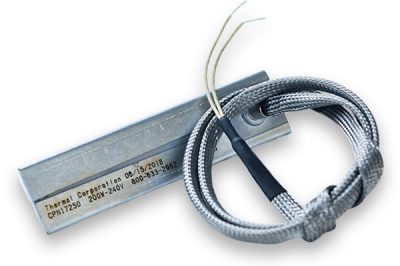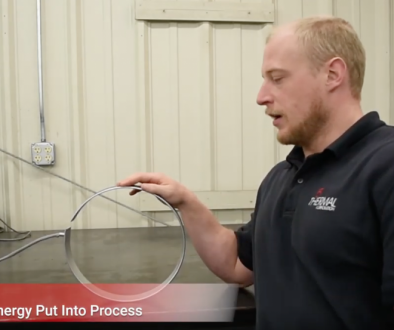How To Extend the Life of Strip Heaters
Home > Blog Archive > Category: Industrial Heating Technology > How to Extend the Life of Strip Heaters
Tips for Extending the Life of Strip Heaters

Because strip heaters and mica band heaters are made of the same materials, these tips will closely mirror those regarding mica band heaters.
#1 Avoiding Contamination
- Moisture is one of the most immediately noticeable contaminants. If sufficient moisture is present at start-up, the heater will fail as soon as power is applied. Sometimes, when the heater has been cooled for a prolonged period and has been subject to a high humidity environment, there will be enough moisture absorbed to cause failure at start-up. Strip heaters are made of mica, which is very hydroscopic, meaning it absorbs water. So, storage in high-humidity areas is not recommended. When insulated lead wire has gotten wet near the heater, the moisture can be wicked into the heater and cause failure. Anytime heaters fail as soon as the power is supplied, moisture is a strong suspect as the culprit.
- If moisture has been detected, the heater can be baked at 200°F for approximately 30 minutes (or longer for larger heaters) to dry the heater out.
- Oil and other organics can cause heater failure if they get inside the metal sheath, but they behave differently than water. Most oils and organics do not conduct electricity very well as lower temperatures, but carbonize and become conductors at elevated temperatures. Thus, if such contaminants are present, the failure occurs only after the heater has gotten hot enough to cause carbonization. Like water, oil that gets on the lead wire insulation can be wicked into the heater.
#2 Avoiding Over-Temperature
- Strip heaters must be clamped down evenly and securely to ensure efficient heat temperature to the heated surface. If the strip heater is not clamped securely, the heat generated will not be transferred efficiently to the surface. This will cause the heater to run at a higher temperature in order to transfer its energy. The higher the operating temperature, the shorter the lifetime. It is good practice to re-tighten the clamping straps or clamping tabs after the first time that the heater has been used, because the heater will be better conformed to the surface during its first heat-up. Anything that prevents a smooth fit of the heater on the surface, such as a surface irregularity, will shorten the life of the heater. This is because the net effect of the irregularity is to make a “loose fit” in spots.
- As strip heaters heat up, they will expand or “grow”. Often times this will cause the heater to bow or bend up away from the surface and lose contact with the heated surface, thus causing hot spots, which in turn causes premature heater failure. A full clamping method (such as sandwiching the heater between two thick plates) is preferred, but the more attachment points or contact points on a strip heater, the better. Similar to band heaters, strip heaters need to be in tight, constant contact with the surface they are meant to heat.
- Choose the lowest wattage heater that will maintain the desired operating temperature of the surface being heated and still provide a short enough start-up time. Choosing a heater with higher wattage than required will result in the controller turning the heater on and off to maintain the desired temperature and a higher operating temperature during on-time. These conditions will shorten the heater’s life.
#3 Avoiding Excessive Cycling
- The way that Thermal Corporation evaluates the lifetime of their own strip heaters and those from competitors is to cycle the units from 150°F to 900°F and count the cycles to failure. Cycling reduces lifetime because the surface of the element wire oxidizes rapidly at higher temperatures; if the higher temperature is maintained, the oxide coating actually protects the wire from further rapid oxidation, but if the wire temperature is reduced substantially, the oxide coating breaks off due to contraction and exposes fresh metal to more oxidation. With continuous cycling, the wire diameter is eventually reduced, and the resistance of the element is increased to the point that it becomes too hot. At that point, the element wire either melts and breaks open the circuit, or it causes the insulation over the wire to break down causing a short to the sheath.
#4 Physical Abuse
- Never carry a strip heater by the lead wires.
- If the heater has post terminals, use two wrenches; one to hold the bottom nut, and one to do the tightening on the top nut.
Conclusion
This concludes today’s blog post. If you have any questions regarding this blog post on extending the life of strip heaters, or have a concern about the life of your strip heater, please contact the Thermal Corporation engineers directly by phone at (800) 633-2962 x152, or by email at engineering@thermalcorp.com.
Click Here to View Our Entire Strip Heater Product Line
We have multiple options available for strip heaters, too! Visit this page to see a list of those options available for strip heaters.
Written by Kyle Otte
Edited by Shelby Reece
Date Published: 01.08.2020
Last Updated: 01.15.2020



